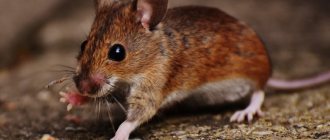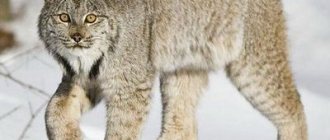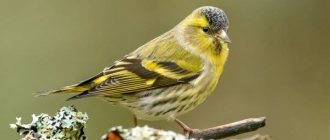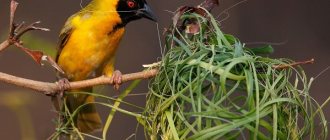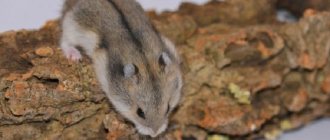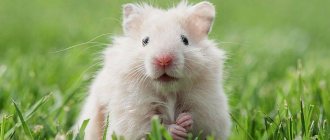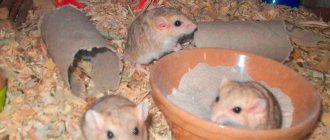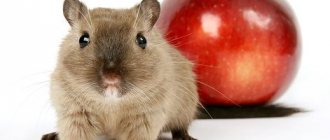Their teeth never stop growing
Like all rodents, hamsters' incisors have no roots and never stop growing. By gnawing on solid foods, chew toys and sticks, hamsters keep their teeth healthy and sharp and prevent overgrowth.
Researchers studying rodent teeth have discovered that their incisors contain active stem cells. This factor, coupled with the fact that rodents constantly regenerate teeth, gives scientists hope that one day they will be able to reproduce the process of tooth regeneration in humans.
Features of determining the sex of babies
Until babies are at least a month old, it is undesirable to recognize their gender. And it’s better not to touch the crumbs at all!
The most common mistake when trying to determine the sex of a hamster is the desire to find out whether the “fluffy” one has testes. But this approach often leads to incorrect conclusions, since some breeds of hamsters (especially Djungarians) have small genitals. In young individuals they are not yet fully formed, and in some mature males the testicles may not descend into the scrotum, but hide in the abdominal cavity.
In cases where the testes are visible to the naked eye, it is impossible to make a mistake in distinguishing a boy from a girl hamster. Almond-shaped, rounded formations in the crotch of the animal can be distinguished from about the sixth week of the “fluffy” life. Over time, the male's testicles increase in size, and determining the sex of a Syrian hamster is not difficult at all.
In other species of rodents, females can be distinguished from males already on the 20-30th day after birth by the location of the urethra relative to the anus. In boys, there is a furry gap between the two holes. In adult Syrian males it is about 1.5 cm (in young animals it is approximately 0.5 cm). In females, the vagina is located almost next to the anus, there are no areas of skin with fur between the openings, and a characteristic bald patch can be seen.
In dwarf species of hamsters, the structure of the genital organs is quite difficult to recognize, and if it is not possible to determine the opening for urine output, then most likely the female must be examined. But the older the animal becomes, the easier it is to recognize its gender.
The ability to determine the sex of a Djungarian hamster or a furry representative of another breed is a mandatory skill for those breeders who want to breed animals. After all, if you pair up incorrectly, you may never have offspring. In addition, same-sex hamsters do not always get along in the same territory, and the stronger representative of the species “harasss” its neighbor.
Animals of different sexes are seated apart from each other in the second month of life. This precautionary measure is aimed at preventing arbitrary crossing of close relatives and avoiding the appearance of defective offspring.
Even when the hamster is kept separately, it is necessary to recognize its gender in order to choose the right name for it. It is illogical to call a boy Cleopatra and a girl Hercules. When an animal is bought for a child, the ability to determine the gender of the hamster will help answer the question of whether it is a boy or a girl, which a young naturalist will certainly ask.
If careful attempts to determine the sex of your pet are unsuccessful, it is advisable to show the animal to a zoologist or veterinarian. To do this, your pet should be taken to the clinic or a specialist should be sent a clear photograph of “interesting places.” You should not rely on the experience of sellers in pet stores.
How to determine the sex of a hamster with high accuracy, how to hold the animal correctly and conduct a safe inspection, a description of inspection methods and signs of sex.
Determining the sex of a hamster is a difficult task only at first glance
This article will tell you how to find the right approach to your pet, what to look for during examination and how not to harm the animal in the process, what are the primary and secondary sex differences
When agreeing to get a hamster, future owners must figure out how to find out the gender of the hamster. Sellers in stores often make mistakes, and sometimes even deliberately deceive, in a hurry to get rid of an overstayed animal. Stories about differences in body color or head shape are just philistine speculation that has no basis.
Determining the sex of a hamster is important in cases where the animals are planned to be bred, or, conversely, to prevent the appearance of offspring. In addition, from the general cage of a pet store you can bring home a female with an unwanted surprise.
Hamsters are thrifty
The word "hamster" comes from the German word "hamstern", which means "to store." Even domestic hamsters will hoard food, despite the lack of such a need. Their cheeks are like tiny bags, which they fill with fruits, grains, roots and leaves. When they find an abundant food source, they fill their cheek pouches and return to their burrows, where they have previously prepared food chambers to store food.
Photo: ISTOCK
The filled cheek pouches can cause a hamster's head to appear twice or even three times its actual size. They have other uses as well. By filling their cheek pouches with air, some hamsters float through the water like an inflatable raft.
Popular names
When choosing a nickname for a hamster, owners take different criteria as a basis. Some pay attention to the appearance and behavior of the animal, others remember simple Russian (human) names, and others look for something original and unusual. Here is a list of nicknames that are most often given to female hamsters:
- Aziza;
- Alice;
- Amalia;
- Anfiska;
- Assol;
- Asya;
- Asha;
- Barbie;
- Bella;
- Bertha;
- Bonnie;
- Bonya;
- Britney;
- Bush;
- Belle;
- Vanga;
- Vicki;
- Vikusya;
- Winky;
- Vitamin;
- Gummy;
- Gel;
- Glasha;
- Glory;
- Greta;
- Pear;
- Dasha;
- Julia;
- Dixie;
- Dinka;
- Dolly;
- Dora;
- Eve;
- Eska;
- Julia;
- Fun;
- Zara;
- Zinka;
- Zoya;
- Zuzu;
- Ilana;
- Irma;
- Yola;
- Yosya;
- Kelly;
- Kiki;
- Kira;
- Klepa;
- Ksyusha;
- Laura;
- Lina;
- Lyra;
- Lulu;
- Lyubava;
- Lucy;
- Mayan;
- Martha;
- Masha;
- Molly;
- Motya;
- Naya;
- Nora;
- Nyuta;
- Ozya;
- Olka;
- Omka;
- Pippi;
- Pinky;
- Fields;
- Rosie;
- Rhonda;
- Rune;
- Sally;
- Samba;
- Stesha;
- Sue;
- Taya;
- Tifi;
- Tosya;
- Tutti;
- Ulya;
- Ursula;
- Thekla;
- Fima;
- Frida;
- Frosya;
- Hannah;
- Helga;
- Hosya;
- Chapa;
- Shanti;
- Sheba;
- Shirley;
- Suga;
- Shura;
- Shusha;
- Elma;
- Esha;
- Yusi;
- Yasya.
Suitable nicknames for Djungarians are Ju-Ju, Judy, Djunga, for Syrians - Basya, Bunny, Vesta, Gipsy, Zuma, Dana, Rayana, Hanuma. If you take two hamsters into your house at once, you can choose names that are consonant with them:
- Zita - Gita;
- Manka - Tanka;
- Mouse - Pine;
- Seed - Fenechka;
- Slipper - Paw, etc.
Fenechka and Semyonka are resting
European hamsters are endangered
There are 19 species of hamsters, but only one species, the European hamster, is now critically endangered. Once widespread throughout Europe, the black-bellied European (or common) hamster is critically endangered. It is the only representative of the genus Cricetus. Its range and population have declined significantly in Western, Central and Eastern Europe. Changes in agricultural practices, commercial and residential development, pollution and climate change are the biggest threats to these small rodents.
Rodent distribution
The largest populations of hamsters live in steppe and forest-steppe zones. In addition, some species live in wet areas along rivers and in mountains at altitudes of up to 3600 m above sea level. Rodents often prefer rice fields, vegetable gardens, orchards and other cultivated areas. Their range covers a large area. Large populations are present in Eastern and Central Europe. Hamsters are also found in Siberia and Asia Minor. Especially many animals live in Iran, Syria, Mongolia, Korea and China. To provide the necessary conditions for the hamster, you need to know where the species was brought from.
Hamsters live in steppe zones.
These are very territorial animals
Photo: Frank Scherbarth
These rodents must live on their own as they are territorial mammals that value their personal space to the point that they will fight each other if personal territory is invaded. This aggressive behavior is especially common among Syrian hamsters. Once they reach maturity, which is 8 to 12 weeks, they should not be kept in pairs or groups. Even the scent of another adult male in the same house can cause irritation, so it is best to always keep only one male.
Methods
Hamsters have many signs by which you can recognize whether the person in front of you is a boy or a girl.
Size. Female hamsters are always larger than males. Specific numbers may vary depending on the breed (dwarf hamsters are almost 3 times smaller than normal ones)
It is worth remembering that to determine sex by size, hamsters must be the same age (this is especially important in the first months of life). Back shape
Hamsters can be identified by the shape of their backs
Back shape. Hamsters can be identified by the shape of their backs
In males, the back tapers towards the tail and the back is slightly raised. In girls, on the contrary, the back is rounder and thicker than the front.
Sexual characteristics Another way to recognize a male is to pay attention to his butt. In males, you will see two almond-shaped testicles. Like many animals, the hamster's testicles are half immersed in his abdominal cavity, and therefore they do not hang, like in humans, but rather stick out
It is worth noting that in dwarf breeds it can be quite difficult to see them due to their small size. If, upon examination, you see that your male pet’s testicles are too large or, on the contrary, you cannot find them, then these are clear signs of illness.
- Behavior. As mentioned earlier, hamsters' behavior may differ depending on their gender. Females are much more active and aggressive than males. However, it is worth noting that this method is the least reliable, since the behavior of hamsters can be influenced not only by their gender.
- Touch your belly. In females, the abdomen should be dry and smooth. In males, the abdomen is almost always wet due to the fluid secreted by the gonads.
- Nipples. In females, several pairs of nipples can be seen on the abdomen. In most breeds they are covered with fur until the female becomes pregnant. To see them, you will have to part the fur on her belly.
- The distance between the genitals and the anus. This is perhaps the most noticeable difference between a girl and a boy hamster. In females this distance is minimal (a few millimeters maximum), while in males it can be from 1 to 2 centimeters, depending on the breed.
- Wool length. Some types of hamsters (for example, Djungarian or Syrian) may differ in fur length. Male Djungarians have a much longer coat and look more luxuriant than females. And female Syrian hamsters have virtually no fur on their bellies.
- Presence of a gonad. Males can also be identified by a gonad on their abdomen. It looks like a small navel or pimple and is located just above the genitals. It is quite small and can most often be found only by touch, but in dwarf breeds it is quite easy to notice. Separately, it is worth noting Syrian hamsters; instead of one gland on their stomach, they have two on the edges of their back.
All these differences will help you understand where the boy is and where the girl is. However, only if we are talking about adult hamsters that are already at least 2-3 months old. In younger individuals, the sexual characteristics are too small to be seen normally, and the size and shape of the back are still almost the same.
But there is still a way to distinguish babies from each other. Newborn hamsters have two pink spots on their butts that are not covered with hair (this is their genitals and anus). In girls, these spots practically merge, but in boys, one of them is located directly under the tail, and the second is almost in the center of the abdomen.
They have one of the shortest gestation periods in the class of mammals
The gestation cycle of a hamster lasts from 15 to 25 days. But if the conditions for birth are not right, they can delay birth by as much as nine days. They give birth to up to four litters per year. Females are very fertile and after giving birth they can become pregnant again on the same day.
But their parents are so-so. It is not uncommon for females to eat their young or abort a pregnancy if the male is not around. Most scientists believe that hamsters do this when the litter is too large and the resources needed to fatten the young are limited. There can be up to 18 cubs in a litter.
Photo: www.pets4homes.co.uk
How do hamsters live?
By their nature, these animals are loners; they are quite aggressive against other individuals. They are trying in every possible way to defend their territory. In the wild, their possessions can be located on an area of up to 10-12 hectares.
Reference. It doesn’t matter what the size of the enemy is, this little one is always ready to stand up for his possessions.
Steppe rodents may well attack a person; you can see their photos below. Bites from their teeth are very painful and may well lead to infection with various diseases; the wounds can be lacerated.
During the day, hamsters rest and gain strength in order to begin an active lifestyle at night. They go in search of supplies. The homes of these rodents are located two meters underground. If the soil is not too dense, the animal will try to equip its house as deeply as possible. Residential cells must have three exits. Two of the doors are necessary for comfortable movement, but the third leads to the pantry, where the rodent stores its precious supplies, which it diligently collects every day.
Reference. An animal can turn to its reserves only in conditions of a cold, frosty period, when there is nowhere to get food, also this is spring. At other times, he feeds on food that he finds daily.
Reference. If cobwebs have accumulated near a rodent’s house, this indicates that the home has already been abandoned, because they always take care of their home.
Surely you have heard that hamsters prefer to lead a passive lifestyle in the cold. This is true, but does not apply to all individuals. Some of them lead an active lifestyle even in winter. Nature has taken care of them; their fur turns white so that they are less noticeable when making forays in the snow.
Those individuals that like to sleep in winter are awake from time to time, at which time they are refreshed by stored delicacies. Only when the earth warms up do the hamsters finally wake up. The animal will feast on its reserves, gain strength, and only after that will open the exit from its hole. Males emerge from their burrows a little earlier than females.
Interesting. Good relations between individuals of different sexes can only be established during the mating season.
Reference. Surprisingly, hamsters are excellent swimmers. Thanks to the cheek pouches that they inflate, you can float on the water like wearing a life jacket.
These are crepuscular animals
Most hamsters are active during twilight hours. Experts believe this is due to the fact that this is when insects, which are a natural part of the rodents' diet, are most active. There is also less light, meaning they are less likely to be caught by predators.
Syrian hamsters are nocturnal, which means they will stay awake at night, burrow, chew, play, and make noise. This is a very important fact to consider before getting a hamster.
Conservation status
Some species cause serious damage to agriculture by eating legumes and grain crops. They are a natural reservoir for pathogens of a number of infectious diseases. The skins of some species are harvested. Hamsters are used as laboratory animals and kept in captivity as pets.
Mesocricetus auratus) is included in the International Red Data Book.
) and Newton's hamster (
Mesocricetus newtoni
).
In Russia there are 12 species of hamsters belonging to 6 genera: rat-shaped hamsters ( Tscherskia
), gray hamsters (
Cricetulus
), hairy-footed hamsters (
Phodopus
), medium-sized hamsters (
Mesocricetus
), true hamsters (
Cricetus
), Eversmann's hamsters (
Allocricetulus
).
Hamsters love to run
Most hamsters are very fast runners, and the shape and size of their hind legs allow them to even run backwards. They can travel up to 15 km per night with a fair wind. Domestic rodents most often run around inside wheels. But if the wheels are too small, they can cause pain, spinal problems and even lead to arthritis. Some hamsters will adamantly refuse to use a wheel that is too small, resulting in unhealthy levels of inactivity. Wheels made from mesh or bars can also be bad for them because they can get stuck or get hurt.
The smartest nicknames
Many hamsters spend most of their time running around the cage, running on a wheel, or picking on other rodents if they are not alone in the house. Names that emphasize their cheerful disposition are suitable for such lively babies:
- Beshka;
- Buyashka;
- View;
- Fidget;
- Zhuzha (Zhuzhunya);
- Bully;
- Playing;
- Yoke;
- Kopusha;
- Kusya;
- Errand;
- Bullet;
- Topotushka (Toptushka);
- Toropyzhka;
- Torpedo;
- Rogue;
- Sheela;
- Shmyga;
- rustling;
- Yula.
Egoza is having fun
They have very poor eyesight
Photo: ISTOCK
After hamsters are born, it takes almost two weeks before they open their eyes. But even then, they are at a disadvantage because they are nearsighted and colorblind. Hamsters use their whiskers and sense of smell to navigate. Try not to touch their nose. They have trouble seeing objects at close range, so when you approach their nose with your hand or finger, it may surprise them. They will become nervous, bite their finger, or simply run away in search of shelter.
Nicknames for lazy people
Some hamsters - in most cases these are Syrians - on the contrary, like to lie down or calmly move through the tunnels equipped for them. In this case, one of these nicknames would be more appropriate:
- Lenivka;
- Mirusha;
- Tenderness;
- Shy;
- Sonya;
- Sopka;
- Tisha;
- Umka (meaning “clever girl”).
Mirusha is never bored
They are susceptible to bacteria and viruses
Hamsters carry salmonella and are also susceptible to lymphocytic choriomeningitis, a virus with symptoms similar to the flu. Children under 5 years of age and pregnant women are especially at risk. The main methods of transmission of zoonoses from hamsters and other rodents to humans are bites, direct contact with the animal, and indirect contact with contaminated objects.
Are there fundamental differences between wild and domesticated individuals?
Domestic and wild rodents have similar body structures, but the animals differ greatly in size. Karbysh is much larger and heavier. The ears of wild species are more massive and clearly visible on the head. The color of the animals is also different; pets often have a beige, golden or white coat. In wild relatives, the body is covered with brown fur with large black and light spots.
The nature of the animals also varies greatly. Pets are calm, peaceful animals. They get used to the presence of a person and allow themselves to be picked up.
Wild individuals are unpredictable and aggressive. They do not tolerate proximity to other animals. A field hamster can bite a person; picking it up is dangerous. This is a wild animal that is very difficult to tame.
A hamster will never bite unless there is a reason for it.
Many people are nervous when handling hamsters due to the fear of being bitten. Yes, a bite can cause severe pain, but if you follow these rules, this will never happen:
- Avoid loud noises, do not keep them near TVs or stereo systems that produce high-frequency sounds;
- wash your hands. Hamsters have poor eyesight but a great sense of smell, and if your hands smell like food... you can bet your hamster will want to try them;
- let them wake up on their own, don't wake them up to play. Instead, schedule your communication for late afternoon or early evening after they are well rested;
- be gentle. Rough touching, sudden movements, grabbing or poking can frighten them and make them nervous. Always scoop them carefully with both hands and stroke them very gently.
Over time, hamsters will adapt to interacting with you, and after a few weeks they will even be waiting for you in their enclosure, ready to play.
Rodent health
Most species are in good health. Older individuals whose body resources are almost exhausted are more likely to get sick.
Lifespan
In nature, rodents rarely live beyond 1 year. This is due to the activity of natural enemies. At home, the life expectancy of most species reaches 3 years.
In nature, rodents reach 1 year of age.
Frequent illnesses
Most often, an animal's health deteriorates due to injury. Damage often occurs due to falls, strong squeezing, and fights with relatives. In addition, metabolic disorders are often diagnosed in older rodents. Your hamster may develop diabetes. Some illnesses are caused by fear and stress. Such pathologies include heart attacks and strokes. These disturbances often lead to the death of old individuals.
It is relatively rare for hamsters to have problems with stool caused by poor diet or intestinal infections. When staying in a draft and getting the fur wet, there is a high probability of developing a runny nose and pneumonia. With a strong decrease in immunity in an adult, the eyes may turn sour. Without treatment, there is a high likelihood of an abscess forming. Some species are predisposed to dermatitis. With age, the risk of developing malignancy increases.
They have the ability to learn
Photo: ISTOCK
With a little time and patience, these little mammals will learn to respond to their names, easily learn routines, become accustomed to cleaning, and will even perform some simple tricks if taught gradually. So the more you handle them, the more fun you'll get from them!
Interesting Facts
The word “hamster” comes from ancient Russian. homeboys
, old glory
homestore. Slavic languages probably borrowed it from Old Iranian; a related word is the Avestan hamaēstar
, “an enemy who throws to the ground” (meaning that the hamster bends the stems of cereals to the ground to get the seeds) [2].
D.-V.-n hamustro
(from where modern English
hamster
and German
Hamster
) was probably borrowed from Old Church Slavonic [2] [3].
The Vietnamese authorities have banned the keeping of hamsters, rightly considering them carriers of dangerous diseases - the reason for such measures was the massive import of animals that had not passed veterinary control from abroad, which was associated with the onset of the Year of the Rat according to the eastern calendar and an increase in demand for small rodents. The maximum fine for violating the ban is 30 million dong (which is about 57,000 rubles) and is comparable to the annual income of a resident of this country. [4]
Rebif, a drug for the pathogenetic treatment of multiple sclerosis, is also produced from a culture of Chinese hamster ovary cells; Alemtuzumap is also made from it, which is used to treat chronic lymphocytic leukemia, and in 2011 it is planned to be approved for use in the Russian Federation for the treatment of multiple sclerosis, since this drug has shown excellent test result.
Hamsters prefer plant foods
Their diet includes seeds, vegetables, fruits and vegetation. Your pet's menu should also include bananas, strawberries or carrots. However, they will become a healthy treat if they make up only about 10% of the total diet. Uneaten food should be removed from their habitat after 24 hours. Fresh fruits and vegetables should not be given more than twice a week.
Caffeine, alcohol, lettuce and avocado are harmful to hamsters. Chocolate contains a chemical called theobromine, which is also toxic to rodents.
Classification
This small subfamily includes 19 species belonging to 6 (7) genera [1]:
- Subfamily Cricetinae
Genus Medium-sized hamsters (
Mesocricetus
) The Syrian hamster (
Mesocricetus auratus
) is popular as a pet, - Brandt's hamster ( Mesocricetus brandti
), - Radde's hamster ( Mesocricetus raddei
), - Newton's hamster ( Mesocricetus newtoni
),
)
- Djungarian hamster ( Phodopus sungorus
),
),
),
- Common hamster ( Cricetus cricetus
),
)
- Short-tailed hamster ( Cricetulus alticola
),
),
),
),
),
)
)
- Mongolian hamster ( Allocricetulus curtatus
),
)
- Cana hamster ( Cansumys canus
)
- Rat-like hamster ( Tscherskia triton
)
